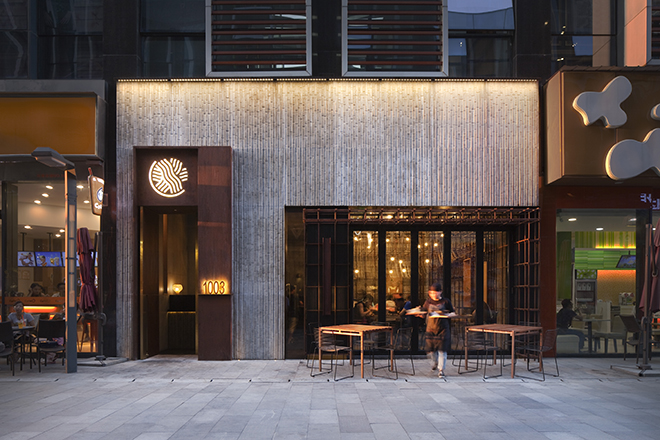Noodle soup is a common street food all over China. While most of these noodle joints make a tremendous effort to win customers with taste, some have started to add attractive store design into their branding recipe.
An example of a noodle bar that seeks to provide its customers with a more comfortable and impressive interior is LongXiaoBao – a new restaurant based in Changsha with an ambition to spread the local ShaoYang-style rice noodle to the rest of China.
Lukstudio was commissioned to conceive a contemporary identity for the restaurant, integrating the tradition of noodle making into the spatial design by reutilising a noodle rack as part of the architecture.
Nestled along an outdoor shopping promenade near the Xiangjiang River, the 50 square metre noodle joint has a calm atmosphere with a touch of mystery, hidden behind a bamboo-cast concrete storefront. Two rustic steel boxes protrude from the solemn exterior to form an entrance to the space – the taller one clad in rusted steel panels and its shorter neighbour built like a metal scaffold. According to the designer, Christine Luk, these three elements together orchestrate a journey of discovery.
Walking past the entry box, customers are greeted by a counter design that features the same bamboo mould pattern used for the exteriors. Proceeding towards the central area, the interior layers begin to reveal themselves.
The original wall has been stripped down to its structural blocks to resonate with the rustic metal grid that covers the space. Secondly, wooden boxes are carefully placed within the rack to showcase selected porcelain. Finally, a series of metal wires are draped across the dining room to create the lighting feature with hanging bulbs. Harmonising with the rustic interiors, these reflective strands create a poetic notion of dining under a vast noodle rack.
Playing with the dualities between rustic and refined, eastern tradition and western representation, Lukstudio introduces a crossover between fast food chain and upscale diner.
The Noodle Rack differentiates itself from the stigma of kitsch fast food ‘hole-in-the-wall’ that can be found on every street in China. It demonstrates how Chinese eateries have the potential to be revitalised and turned into cool gathering spots.



